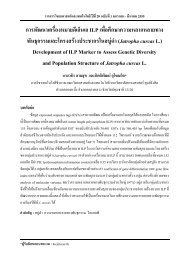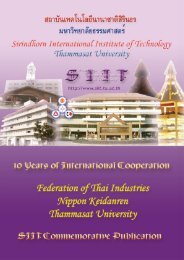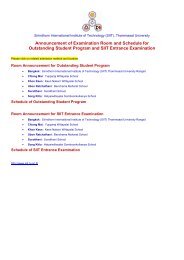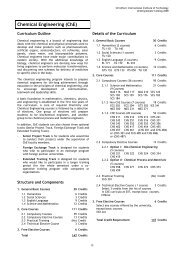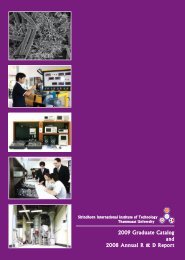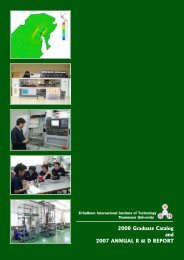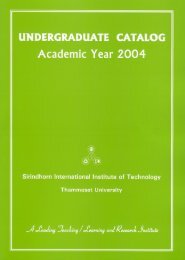2006 Graduate Catalog and 2005 Annual R & D Report - Sirindhorn ...
2006 Graduate Catalog and 2005 Annual R & D Report - Sirindhorn ...
2006 Graduate Catalog and 2005 Annual R & D Report - Sirindhorn ...
Create successful ePaper yourself
Turn your PDF publications into a flip-book with our unique Google optimized e-Paper software.
<strong>2006</strong> <strong>Graduate</strong> <strong>Catalog</strong> <strong>and</strong> <strong>2005</strong> <strong>Annual</strong> R & D <strong>Report</strong><br />
<strong>Sirindhorn</strong> International Institute of Technology (SIIT)<br />
development. Monetary gain has dominated over<br />
environmental quality <strong>and</strong> the sustainability of natural<br />
resources. If a polluting factory yields a profit now, the<br />
effect on generations is forgotten. All this is carried<br />
out in the name of development <strong>and</strong> for the<br />
betterment of the quality of life without foreseeing the<br />
effect on the environment, which is the key<br />
component for sustainable development. Thus, it is<br />
necessary to analyze the existing situation <strong>and</strong><br />
suggest measures to minimize the impacts on the<br />
environment <strong>and</strong> to conserve the finite natural<br />
resources. Life cycle assessemnt can be used as one<br />
of the tools to identify <strong>and</strong> assess the environmental<br />
burdens of different products or system over the<br />
entire period of its life.<br />
Membrane Technology for Water Treatment<br />
Membrane technology is an alternative to the long<br />
established conventional treatment techniques for the<br />
production of drinking water from various natural<br />
resources <strong>and</strong> its application to water treatment<br />
processes is now exp<strong>and</strong>ing rapidly due to stringent<br />
regulations. Membrane processes are capable of<br />
removing many materials from water that are typically<br />
treated using unit processes ranging from s<strong>and</strong><br />
filtration to carbon adsorption to ion exchange. There<br />
is plenty of scope to focus research work on<br />
treatment of water by membranes <strong>and</strong> underst<strong>and</strong>ing<br />
the fouling phenomenon leading to the development<br />
of low-cost solutions to the drinking-water treatment<br />
problems.<br />
Dr. Suwanchai Nitisoravut<br />
Associate Professor<br />
Diploma (Honors) in Analytical Chemistry, Institute of Analytical Chemistry Training, Ministry of Science,<br />
Technology, <strong>and</strong> Environment, Bangkok, Thail<strong>and</strong><br />
B.S. in Chemical Technology/Chemical Engineering, Chulalongkorn University, Thail<strong>and</strong><br />
M.S. in Biosystem Engineering, University of Hawaii at Manoa, Hawaii, USA<br />
Ph.D. in Civil/Environmental Engineering, North Carolina State University, North Carolina, USA<br />
Areas of Specialization: Environmental Biotechnology/Microbiology, Biological treatment of water <strong>and</strong><br />
wastewater.<br />
Research Interests:<br />
Biological Nitrogen Transformation Using the<br />
ANAMMOX Process<br />
The ANoxic AMMonium OXidation (ANAMMOX)<br />
process involves the use of nitrite as an electron<br />
acceptor in the bacterially mediated oxidation of<br />
ammonia to yield di-nitrogen gas. The process allows<br />
a nitrogen transformation similar to the classical<br />
processes of nitrification followed by denitrification.<br />
This reduces both oxygen dem<strong>and</strong> in the nitrification<br />
<strong>and</strong> additional organic carbon as chemical oxygen<br />
dem<strong>and</strong> (COD) in the denitrification phases. It is a<br />
new <strong>and</strong> promising microbial process to remove<br />
ammonia from wastewater characterized by a low<br />
content of organic materials.<br />
Assimilable Organic Carbon (AOC) <strong>and</strong> Regrowth<br />
Potential in Drinking Water<br />
During the last decade, research interest in drinking<br />
water treatment has focused on the biodegradable<br />
fraction of organic carbon in natural <strong>and</strong> treated<br />
water. This interest stems from the recognition that<br />
biodegradable organic matter in water can provide<br />
growth support to microorganisms which can be<br />
intensified during storage <strong>and</strong> travel within the<br />
distribution systems. Such phenomenon is known as<br />
biological regrowth <strong>and</strong> the fraction of biodegradable<br />
organic carbon is commonly termed biodegradable<br />
dissolved organic carbon (BDOC) or assimilable<br />
organic carbon (AOC). Biological regrowth in<br />
distribution systems has been known for years, as a<br />
potential cause of corrosion in distribution lines <strong>and</strong><br />
deterioration of finished water quality, as well as an<br />
indirect link to waterborne diseases. It has, however,<br />
just come into attention, particularly for developed<br />
countries, due to the unclear impact on human health.<br />
Previous research has found that AOC can be<br />
effectively removed in an immobilized cell bioreactor.<br />
Cell-immobilization Technology for Waste<br />
Treatment<br />
It is generally known that microbial cells play an<br />
important role in biological treatment. To further<br />
enhance the process, the microbes can be<br />
immobilized in polymeric material which will provide a<br />
protective environment for the cells against toxic<br />
substances. At the same time, the microbial<br />
population can be intensified inside the carrier, thus<br />
allowing immediate biological activity for waste<br />
treatment. The technology has been proven feasible<br />
<strong>and</strong> effective in treating wastes biologically under<br />
severe conditions such as high toxic concentration<br />
<strong>and</strong> starvation environments. Previous research<br />
involving cell immobilization included the denitrification<br />
of spent regenerant from ion exchange processes<br />
<strong>and</strong> biodegradation of trace amounts of assimilable<br />
organic carbon in drinking water. The technology is<br />
believed to have a broad application which has yet to<br />
be explored.<br />
14




